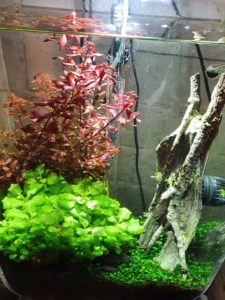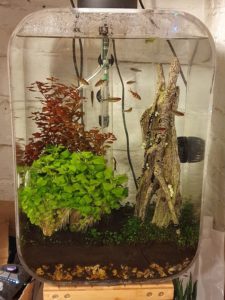Simulated daily light programme
My daily lighting sequence with the Kessil A80 LED light controlled by a mains timer was pretty straightforward: lights off for 18 hours per day and lights on full for 6 hours per day. That’s fine but of occasion I’d head into work with the lights off and they’d already be off by time I came back home. The problem is you can’t really extend the lit period very much before the algae starts to grow like crazy. As a way around this I picked up a Kessil “Spectral Controller” which is a programmable timer that plugs into the light and lets you adjust both the light intensity and light colour throughout the day.
The video shows a looped simulation of my current lighting pattern – this is from the controller doing a “preview” of the programme so it’s very sped up and not done to time-period scale. When I was using the mains timer, the “on” setting meant the light at full power (100% intensity) and a mostly white end of the spectrum colour (80% colour). I like the look of that and the plants do well with it so I kept that setting for the main lights-on period with the spectral controller during the day. I then added periods of extended low intensity on either side of the main lights-on period, and some gradual ramps up and down between those. Brighter and bluer during the middle of the day, dimmer and redder in the morning and evening.
Current lighting programme:
- 00:00 – 09:00: lights off
- 09:00 – 10:00: 5% intensity (lowest possible setting without turning off), 0% colour (as “warm” or “reddish” as possible)
- 10:00 – 10:30 smoothly ramp up both the intensity and colour of the light to get to…
- 10:30 – 15:00 100% intensity, 80% colour (the “on” setting with the mains timer)
- 15:00 – 17:00 smoothly ramp down both the intensity and colour of the light to get to…
- 17:00 – 18:00 5% intensity, 0% colour
- 18:00 – 00:00 lights off
The extended low light periods are good for observation purposes. The fish don’t seem to behave radically differently. They still show the same lights on behavior vs. lights off behavior, but with some larger amount of intermediate swimming, particularly while the light intensity is ramping down at the end of the day. It’s too soon to say whether the algae or plant growth will be different.





